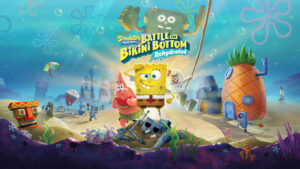
I think it’s worth mentioning the cult status of this game when doing this review, as some people might be unaware of why this licensed cartoon video game out of all licensed cartoon video games has the internet abuzz.
Originally released in 2003 for the PlayStation 2, Xbox, and GameCube SpongeBob SquarePants: Battle for Bikini Bottom came out near the end of the time when collect-a-thon games such as Banjo-Kazooie, Spyro The Dragon, and I-Ninja were popular.
Due to the popularity of the SpongeBob SquarePants franchise on Nickelodeon, and the strong popularity for the collect-a-thon genre, it created a perfect situation for THQ to release a surprisingly good licensed game.
Popularity among the speedrunning community has also contributed to the game’s surprising staying power, with a new world record being set as recently as April 2020. With all that being said, let’s get into the new game.
SpongeBob SquarePants: Battle for Bikini Bottom Rehydrated
Developer: Purple Lamp Studios
Publisher: THQ Nordic
Platforms: Windows PC, Nintendo Switch (Reviewed), PlayStation 4, Xbox One
Release Date: June 23rd, 2020
Players: 1-2 Players
Price: $29.99
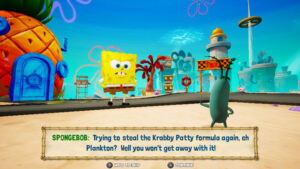
Video games based off of movies and cartoons have a bad reputation, and deservedly so in many cases. Which makes SpongeBob SquarePants: Battle for Bikini Bottom Rehydrated a surprise 17 years after the game’s original release.
Boasting updated graphics, previously cut content, and a brand new co-op multiplayer mode; Battle for Bikini Bottom Rehydrated tries to tempt fans of the original game to rescue Bikini Bottom once again.
After a poorly executed plan to create an army of robots by Plankton, Bikini Bottom is overrun by the machines. It’s up to SpongeBob, Patrick, and Sandy to collect Golden Spatulas in order to get inside the Chum Bucket and stop the problem at the source.
Each of the three playable characters has unique abilities, and not every character is necessary for every stage. SpongeBob can headbutt, bowl with bubbles, and create a guided bubble missile. Patrick can lift and throw tikis and special fruits. Namely “Throw Fruits,” which can be used to bash enemies, make small steps, and activate switches.
“Freezy Fruits” are thrown at goo water hazards to temporarily freeze them and make them passable. Finally Sandy can lasso enemies, and onto floating Texas-shaped swings. She can also spin her lasso and glide for short periods of time to cover far distances and make precise jumps.
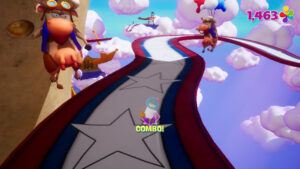
The game starts off with a simple tutorial, exploring SpongeBob’s house and learning the different collectables you’ll find on your adventure. Golden Spatulas are the main objective of the game, similar to stars in Super Mario 64, progress through the game is gated by the number of Golden Spatulas collected.
Patrick’s socks are also hidden throughout stages, normally tucked away in forgotten corners, or a reward for subtle minigames that need to be discovered. Ten socks can be traded for a single Golden Spatula. Flower symbols called “Shiny Objects” are saturated throughout the environment, and respawn on a loading screen making them virtually infinite. Shinies can be used to unlock new features in a stage, or get golden spatulas from Mr. Krabs.
Frankly, the Shiny Objects seem to only exist to help designate paths, and give a minor reward for basic gameplay elements like defeating enemies. Due to their unlimited nature and how there’s no reason to methodically try and find every single one in a stage, collecting them is a chore rather than a challenge.
This is made all the worse by how the game teases that the purple Shiny Objects are worth more (They’re only worth fifty, a cluster of tikis are easily worth more), and wastes potential secret spots better served housing Patrick’s Socks or other more worthwhile secrets.
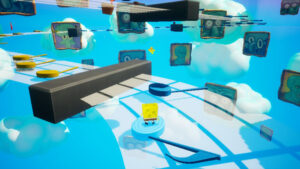
Stage design is inconsistent but fun. Some stages require precise jumps, while others allow for creative skipping. It makes it difficult to tell what the intended path is, especially on sledding segments in Sand Mountain, where you’re expected to find shortcuts and use unorthodox jumps.
The game suffers from serious graphical issues, at least on the Nintendo Switch. Small draw distances, framerate drops, and long loading times on textures are the largest issues plaguing the game. The game was played entirely in handheld mode when doing this review, and similar issues may not exist when docked or on other consoles.
When the game does choose to run well, it’s passable. It’s not silky smooth 4K HD with 60 frames per second, but it doesn’t have to be. It’s SpongeBob. It’s fun and, despite what some studios say, fun is important.

The platforming is fluid and precise on some of the harder levels, and it’s a good feeling when you’re able to solve a particular jumping puzzle or clear a challenge. Collecting Golden Spatulas and Patrick’s Socks are fun and rewarding challenges in contrast to the tedium of collecting Shiny Objects. Completing a secret objective or just exploring can yield one of these treasures.
At Goo Lagoon I fell off a platform and found a hidden Golden Spatula under the stage. After trying to finesse the jump, I later found out the challenge was meant to be done with Freezy Fruits as Patrick; but I could have easily missed it without proper exploration.
The way Golden Spatulas are organized is reminiscent of Stars in Super Mario 64, and players are able to quick travel to Golden Spatula challenges from the start menu once they’re discovered. This mitigates the downtime of walking across each stage. Despite the warp points and checkpoints, stages are massive and usually split up into multiple segments, which makes any backtracking discouraging and frustrating.
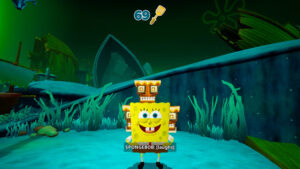
However it’s not all fun and games, and much like the graphics, some of the gameplay suffers from a lack of polish as well. Some enemies aren’t intuitive to fight; tartar sauce shooting robots recover from their hitstun almost immediately, and retaliate before being able to land a second blow.
Flame spewing robots in inner tubes that stack on top of one another are tricky to deal with, because the top robot is at the very peak of your jump. With the jump button and attack button being across from each other on the game pad, it’s up to chance whether you hit the attack button quick enough.
This wouldn’t be a problem if the game had remappable buttons, or even an alternate control scheme that kept jump and attack near each other. Instead, attack and ground-pound are next to one another, and jumps can be cut short by fat-fingering the ground-pound button.
In contrast to the annoying rank and file enemies, the boss fights are fun and appropriately challenging. Learning the patterns of boss moves (especially the last boss) and being able to dodge takes a surprising amount of skill for a game based off a children’s cartoon.
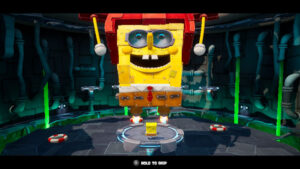
SpongeBob SquarePants: Battle for Bikini Bottom Rehydrated ultimately achieves what it sets out to do. It’s an updated remake of a beloved game from 2003, warts and all.
While the gameplay issues and poor graphics (at least on the Nintendo Switch version) may deter players, fans of the original game or fans of collect-a-thons like Banjo-Kazooie and A Hat In Time will likely welcome the remake despite its flaws. The graphics might be lacking, the gameplay might be janky, but it’s fun.
SpongeBob SquarePants: Battle for Bikini Bottom Rehydrated was reviewed on the Nintendo Switch using a review copy provided by THQ Nordic. You can find additional information about Niche Gamer’s review/ethics policy here.
Some Images: Nintendo